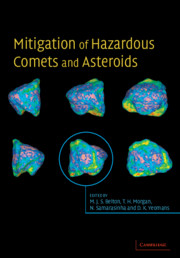Book contents
- Frontmatter
- Contents
- List of contributors
- Preface
- Acknowledgments
- Glossary
- 1 Recent progress in interpreting the nature of the near-Earth object population
- 2 Earth impactors: orbital characteristics and warning times
- 3 The role of radar in predicting and preventing asteroid and comet collisions with Earth
- 4 Interior structures for asteroids and cometary nuclei
- 5 What we know and don't know about surfaces of potentially hazardous small bodies
- 6 About deflecting asteroids and comets
- 7 Scientific requirements for understanding the near-Earth asteroid population
- 8 Physical properties of comets and asteroids inferred from fireball observations
- 9 Mitigation technologies and their requirements
- 10 Peering inside near-Earth objects with radio tomography
- 11 Seismological investigation of asteroid and comet interiors
- 12 Lander and penetrator science for near-Earth object mitigation studies
- 13 Optimal interception and deflection of Earth-approaching asteroids using low-thrust electric propulsion
- 14 Close proximity operations at small bodies: orbiting, hovering, and hopping
- 15 Mission operations in low-gravity regolith and dust
- 16 Impacts and the public: communicating the nature of the impact hazard
- 17 Towards a national program to remove the threat of hazardous NEOs
- Index
5 - What we know and don't know about surfaces of potentially hazardous small bodies
Published online by Cambridge University Press: 12 October 2009
- Frontmatter
- Contents
- List of contributors
- Preface
- Acknowledgments
- Glossary
- 1 Recent progress in interpreting the nature of the near-Earth object population
- 2 Earth impactors: orbital characteristics and warning times
- 3 The role of radar in predicting and preventing asteroid and comet collisions with Earth
- 4 Interior structures for asteroids and cometary nuclei
- 5 What we know and don't know about surfaces of potentially hazardous small bodies
- 6 About deflecting asteroids and comets
- 7 Scientific requirements for understanding the near-Earth asteroid population
- 8 Physical properties of comets and asteroids inferred from fireball observations
- 9 Mitigation technologies and their requirements
- 10 Peering inside near-Earth objects with radio tomography
- 11 Seismological investigation of asteroid and comet interiors
- 12 Lander and penetrator science for near-Earth object mitigation studies
- 13 Optimal interception and deflection of Earth-approaching asteroids using low-thrust electric propulsion
- 14 Close proximity operations at small bodies: orbiting, hovering, and hopping
- 15 Mission operations in low-gravity regolith and dust
- 16 Impacts and the public: communicating the nature of the impact hazard
- 17 Towards a national program to remove the threat of hazardous NEOs
- Index
Summary
Introduction
One of the most fundamental aspects of mitigating an impact threat by moving an asteroid or comet involves physical interaction with the body. Whether one is bathing the body's surface with neutrons, zapping it with a laser or solar-reflected beam, bolting an ion thruster or mass driver onto the surface, or trying to penetrate the surface in order to implant a device below the surface, we need to understand the physical attributes of the surface and sub-surface. Of course, we would critically wish to understand the surface of the particular body that is, most unluckily, found to be headed for Earth impact – should that eventuality come to pass. But, in the event that we have relatively little warning time, it might behoove us to examine well in advance the potential range of small-body surface environments that we might have to deal with. It will improve our ability to design experiments and understand data concerning the particular body if we have evaluated, beforehand, the range of surface properties we might encounter and have specified the kinds of measurement techniques that will robustly determine the important parameters that we would want to know.
We already know, from meteorite falls, that asteroidal materials can range from strong nickel–iron alloy (of which most smaller crater-forming meteorites, like Canyon Diablo, are made) to mud-like materials (like the remnants of the Tagish Lake fireball event). But the diversity could be even greater, especially on the softer/weaker end of the spectrum, because the Earth's atmosphere filters out such materials.
- Type
- Chapter
- Information
- Mitigation of Hazardous Comets and Asteroids , pp. 104 - 112Publisher: Cambridge University PressPrint publication year: 2004

